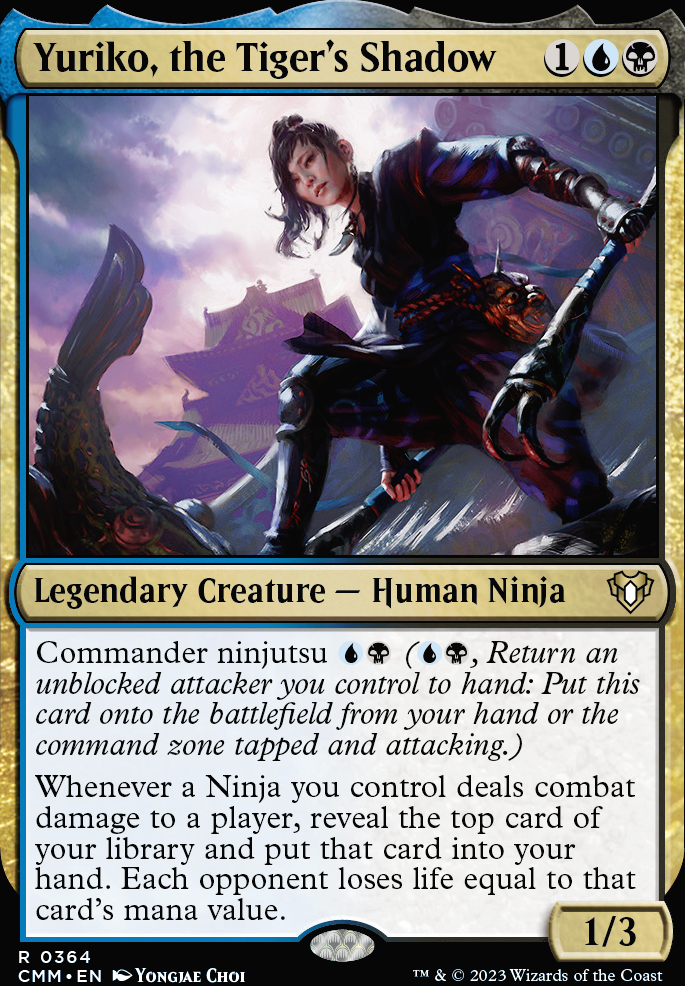
Stealthy Interchangeables *PRIMER*
Commander / EDH Casual Multiplayer Ninja Ninjutsu UB (Dimir) Unblockable
Creature (28)
- 1x Baleful Strix
- 1x Dauthi Voidwalker
- 1x Faerie Mastermind
- 1x Fallen Shinobi
- 1x Higure, the Still Wind
-
1x
Ingenious Infiltrator

- 1x Ink-Eyes, Servant of Oni
- 1x Invisible Stalker
- 1x Mist-Syndicate Naga
- 1x Mistblade Shinobi
- 1x Necropolis Regent
- 1x Nightveil Specter
- 1x Prosperous Thief
- 1x Roaming Throne
- 1x Satoru Umezawa
- 1x Shadowmage Infiltrator
- 1x Silent-Blade Oni
- 1x Silver-Fur Master
- 1x Skullsnatcher
- 1x Solemn Simulacrum
- 1x Tetsuko Umezawa, Fugitive
- 1x Thalakos Seer
- 1x Thassa, God of the Sea
- 1x Thousand-Faced Shadow
- 1x Throat Slitter
- 1x Throatseeker
- 1x Varragoth, Bloodsky Sire
- 1x Walker of Secret Ways
Enchantment (6)
Land (35)
- 1x Blast Zone
-
1x
Bloodstained Mire

- 1x Cabal Coffers
- 1x Cavern of Souls
- 1x Choked Estuary
- 1x Command Tower
- 1x Drowned Catacomb
-
1x
Flooded Strand

- 5x Island
- 1x Mana Confluence
- 1x Marsh Flats
- 1x Misty Rainforest
- 1x Nykthos, Shrine to Nyx
- 1x Polluted Delta
- 1x Reflecting Pool
- 1x Reliquary Tower
- 1x Scalding Tarn
- 1x Shipwreck Marsh
- 1x Sunken Hollow
- 1x Sunken Ruins
- 5x Swamp
- 1x Tainted Isle
- 1x Temple of Deceit
- 1x Underground River
- 1x Urborg, Tomb of Yawgmoth
- 1x Verdant Catacombs
- 1x Watery Grave
Sorcery (6)
Commander (1)
Artifact (15)
- 1x Arcane Signet
- 1x Bident of Thassa
- 1x Cloudstone Curio
- 1x Dimir Signet
- 1x Elbrus, the Binding Blade Flip
- 1x Jet Medallion
- 1x Mind Stone
- 1x Sapphire Medallion
- 1x Sensei's Divining Top
- 1x Sol Ring
- 1x Sword of Feast and Famine
- 1x Sword of the Animist
- 1x Talisman of Dominance
- 1x Urza's Incubator
- 1x Vorpal Sword
Instant (9)
Suggestions
Updates Add
Comments View Archive
Attention! Complete Comment Tutorial! This annoying message will go away once you do!
Important! Formatting tips — Comment Tutorial — markdown syntax
Please login to comment
98% Casual
Competitive
| Date added | 6 years |
| Last updated | 1 week |
| Legality | This deck is Commander / EDH legal. |
| Rarity (main - side) | 16 - 0 Mythic Rares 45 - 0 Rares 18 - 0 Uncommons 11 - 0 Commons |
| Cards | 100 |
| Avg. CMC | 2.83 |
| Tokens | Boar 2/2 G, Copy Clone, Ninja 1/1 U, Treasure |
| Votes | |
| Ignored suggestions | |
| Shared with | |
| Views |

